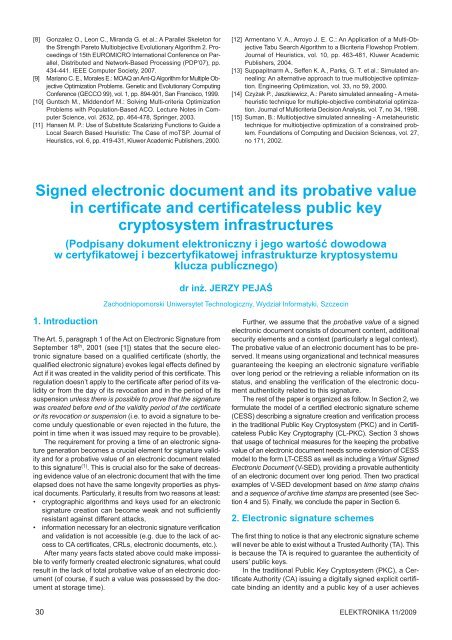Elektronika 2009-11.pdf - Instytut Systemów Elektronicznych
Elektronika 2009-11.pdf - Instytut Systemów Elektronicznych
Elektronika 2009-11.pdf - Instytut Systemów Elektronicznych
You also want an ePaper? Increase the reach of your titles
YUMPU automatically turns print PDFs into web optimized ePapers that Google loves.
[8] Gonzalez O., Leon C., Miranda G. et al.: A Parallel Skeleton for<br />
the Strength Pareto Multiobjective Evolutionary Algorithm 2. Proceedings<br />
of 15th EUROMICRO International Conference on Parallel,<br />
Distributed and Network-Based Processing (PDP’07), pp.<br />
434-441. IEEE Computer Society, 2007.<br />
[9] Mariano C. E., Morales E.: MOAQ anAnt-QAlgorithm for Multiple Objective<br />
Optimization Problems. Genetic and Evolutionary Computing<br />
Conference (GECCO 99), vol. 1, pp. 894-901, San Francisco, 1999.<br />
[10] Guntsch M., Middendorf M.: Solving Multi-criteria Optimization<br />
Problems with Population-Based ACO. Lecture Notes in Computer<br />
Science, vol. 2632, pp. 464-478, Springer, 2003.<br />
[11] Hansen M. P.: Use of Substitute Scalarizing Functions to Guide a<br />
Local Search Based Heuristic: The Case of moTSP. Journal of<br />
Heuristics, vol. 6, pp. 419-431, Kluwer Academic Publishers, 2000.<br />
[12] Armentano V. A., Arroyo J. E. C.: An Application of a Multi-Objective<br />
Tabu Search Algorithm to a Bicriteria Flowshop Problem.<br />
Journal of Heuristics, vol. 10, pp. 463-481, Kluwer Academic<br />
Publishers, 2004.<br />
[13] Suppapitnarm A., Seffen K. A., Parks, G. T. et al.: Simulated annealing:<br />
An alternative approach to true multiobjective optimization.<br />
Engineering Optimization, vol. 33, no 59, 2000.<br />
[14] Czyżak P., Jaszkiewicz, A.: Pareto simulated annealing - A metaheuristic<br />
technique for multiple-objective combinatorial optimization.<br />
Journal of Multicriteria Decision Analysis, vol. 7, no 34, 1998.<br />
[15] Suman, B.: Multiobjective simulated annealing - A metaheuristic<br />
technique for multiobjective optimization of a constrained problem.<br />
Foundations of Computing and Decision Sciences, vol. 27,<br />
no 171, 2002.<br />
Signed electronic document and its probative value<br />
in certificate and certificateless public key<br />
cryptosystem infrastructures<br />
(Podpisany dokument elektroniczny i jego wartość dowodowa<br />
w certyfikatowej i bezcertyfikatowej infrastrukturze kryptosystemu<br />
klucza publicznego)<br />
dr inż. JERZY PEJAŚ<br />
Zachodniopomorski Uniwersytet Technologiczny, Wydział Informatyki, Szczecin<br />
1. Introduction<br />
The Art. 5, paragraph 1 of the Act on Electronic Signature from<br />
September 18 th , 2001 (see [1]) states that the secure electronic<br />
signature based on a qualified certificate (shortly, the<br />
qualified electronic signature) evokes legal effects defined by<br />
Act if it was created in the validity period of this certificate. This<br />
regulation doesn’t apply to the certificate after period of its validity<br />
or from the day of its revocation and in the period of its<br />
suspension unless there is possible to prove that the signature<br />
was created before end of the validity period of the certificate<br />
or its revocation or suspension (i.e. to avoid a signature to become<br />
unduly questionable or even rejected in the future, the<br />
point in time when it was issued may require to be provable).<br />
The requirement for proving a time of an electronic signature<br />
generation becomes a crucial element for signature validity<br />
and for a probative value of an electronic document related<br />
to this signature (1) . This is crucial also for the sake of decreasing<br />
evidence value of an electronic document that with the time<br />
elapsed does not have the same longevity properties as physical<br />
documents. Particularly, it results from two reasons at least:<br />
• cryptographic algorithms and keys used for an electronic<br />
signature creation can become weak and not sufficiently<br />
resistant against different attacks,<br />
• information necessary for an electronic signature verification<br />
and validation is not accessible (e.g. due to the lack of access<br />
to CA certificates, CRLs, electronic documents, etc.).<br />
After many years facts stated above could make impossible<br />
to verify formerly created electronic signatures, what could<br />
result in the lack of total probative value of an electronic document<br />
(of course, if such a value was possessed by the document<br />
at storage time).<br />
Further, we assume that the probative value of a signed<br />
electronic document consists of document content, additional<br />
security elements and a context (particularly a legal context).<br />
The probative value of an electronic document has to be preserved.<br />
It means using organizational and technical measures<br />
guaranteeing the keeping an electronic signature verifiable<br />
over long period or the retrieving a reliable information on its<br />
status, and enabling the verification of the electronic document<br />
authenticity related to this signature.<br />
The rest of the paper is organized as follow. In Section 2, we<br />
formulate the model of a certified electronic signature scheme<br />
(CESS) describing a signature creation and verification process<br />
in the traditional Public Key Cryptosystem (PKC) and in Certificateless<br />
Public Key Cryptography (CL-PKC). Section 3 shows<br />
that usage of technical measures for the keeping the probative<br />
value of an electronic document needs some extension of CESS<br />
model to the form LT-CESS as well as including a Virtual Signed<br />
Electronic Document (V-SED), providing a provable authenticity<br />
of an electronic document over long period. Then two practical<br />
examples of V-SED development based on time stamp chains<br />
and a sequence of archive time stamps are presented (see Section<br />
4 and 5). Finally, we conclude the paper in Section 6.<br />
2. Electronic signature schemes<br />
The first thing to notice is that any electronic signature scheme<br />
will never be able to exist without a Trusted Authority (TA). This<br />
is because the TA is required to guarantee the authenticity of<br />
users’ public keys.<br />
In the traditional Public Key Cryptosystem (PKC), a Certificate<br />
Authority (CA) issuing a digitally signed explicit certificate<br />
binding an identity and a public key of a user achieves<br />
30 ELEKTRONIKA 11/<strong>2009</strong>

















